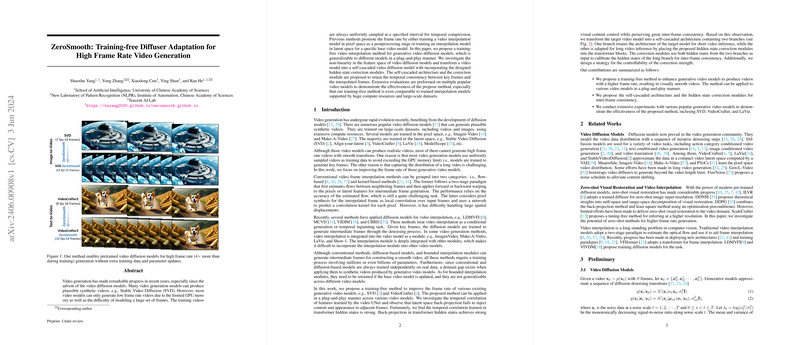Analysis of "ZeroSmooth: Training-free Diffuser Adaptation for High Frame Rate Video Generation"
The paper "ZeroSmooth: Training-free Diffuser Adaptation for High Frame Rate Video Generation," authored by Shaoshu Yang, Yong Zhang, Xiaodong Cun, Ying Shan, and Ran He, presents a novel framework for video generation. This research addresses the challenges in generating high frame rate videos using pre-trained video diffusion models without requiring additional training or parameter updates.
Scope and Methodology
The video generation domain has seen advancements through diffusion models capable of generating plausible synthetic videos. However, achieving high frame rates with these models often demands substantial computational resources and extensive datasets, which exceed current GPU memory capacities. Traditional approaches have relied heavily on video frame interpolation as a postprocessing stage, either in pixel or latent space. Such approaches necessitate significant computational overhead and retraining efforts.
The proposed technique, ZeroSmooth, innovatively circumvents these computational limitations by utilizing pre-trained models and enhancing them in a "plug-and-play" manner. ZeroSmooth works by transforming an existing video diffusion model into a self-cascaded framework using hidden state correction modules, facilitating the interpolation of additional frames between key frames. This framework cleverly exploits the temporal consistency found in transformer hidden states, allowing for the alignment of both key and interpolated frames without retraining the model. This design choice distinguishes ZeroSmooth from other models, which often face shortcomings due to domain gaps or the need to retrain models upon any updates.
Key Contributions
- Training-Free Enhancement: ZeroSmooth stands out by enabling high frame rate video generation from pre-trained models without additional training. This is achieved using a self-cascaded architecture that introduces hidden state correction for maintaining the temporal consistency between interpolated and key frames.
- Self-Cascaded Design with Correction Modules: The transformation into a self-cascaded model allows for better temporal coherence as the cascade inherently corrects hidden states, which aids in maintaining visual consistency across frames.
- Empirical Evaluation: The paper details extensive experimentation across multiple popular video models, including Stable Video Diffusion (SVD), VideoCrafter, and LaVie. ZeroSmooth exhibits comparable or superior results when assessed against both conventional methods and training-intensive approaches. Metrics used included Inception Score (IS) and Frechet Video Distance (FVD), showing high visual quality and temporal consistency.
Theoretical and Practical Implications
ZeroSmooth contributes significantly to both theoretical understanding and practical advancements in video generation. Theoretically, it underscores the potential of hidden state manipulation in neural networks to achieve better temporal interpolation without retraining. Practically, ZeroSmooth offers a scalable solution to generate high frame rate videos, benefiting applications across media production, surveillance systems, and virtual reality environments where high frame rates are critical.
Future Prospects
This paper paves the way for further exploration into zero-shot learning methods for video enhancement tasks and integrating such frameworks directly into production pipelines. Future research could explore optimizing the computational efficiency of hidden state corrections further or expanding the framework's applicability across diverse video generation tasks, including style transfer and video editing.
In conclusion, ZeroSmooth successfully addresses the pressing challenge of high frame rate video generation using existing pre-trained models, thus providing a viable, resource-efficient alternative to existing methods that demand extensive retraining or computational allocations. This method holds promise for broader application and continued refinement in the field of video synthesis.
